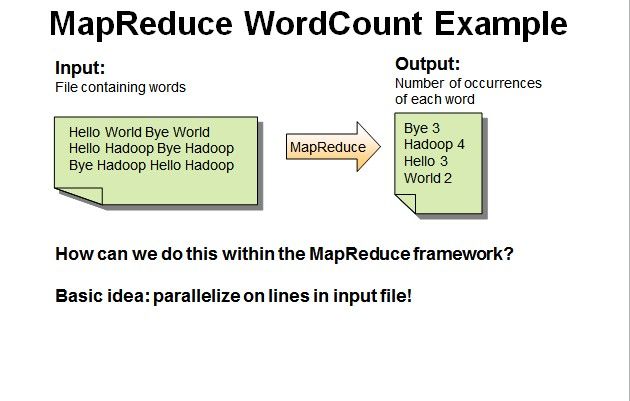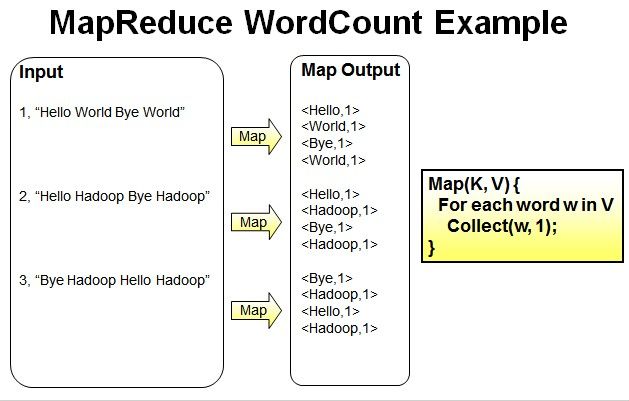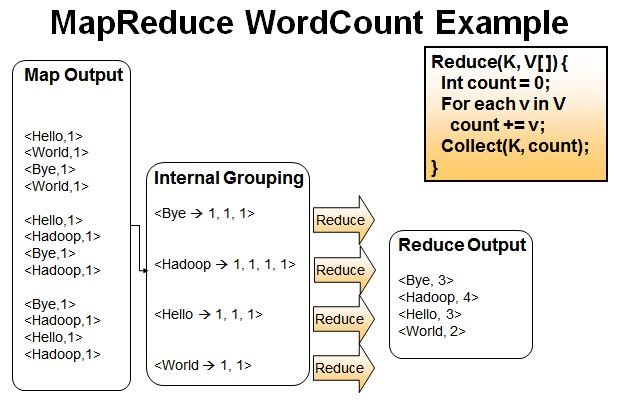Hadoop示例程序WordCount详解及实例
部分参考:http://www.javaeye.com/topic/606962
1.图解MapReduce
MapReduce整体流程图

并行读取文本中的内容,然后进行MapReduce操作

Map过程:并行读取三行,对读取的单词进行map操作,每个词都以<key,value>形式生成

reduce操作是对map的结果进行排序,合并,最后得出词频。

2.简单过程:
Input:
Hello World Bye World
Hello Hadoop Bye Hadoop
Bye Hadoop Hello Hadoop
Map:
<Hello,1>
<World,1>
<Bye,1>
<World,1>
<Hello,1>
<Hadoop,1>
<Bye,1>
<Hadoop,1>
<Bye,1>
<Hadoop,1>
<Hello,1>
<Hadoop,1>
Sort:
<Bye,1>
<Bye,1>
<Bye,1>
<Hadoop,1>
<Hadoop,1>
<Hadoop,1>
<Hadoop,1>
<Hello,1>
<Hello,1>
<Hello,1>
<World,1>
<World,1>
Combine:
<Bye,1,1,1>
<Hadoop,1,1,1,1>
<Hello,1,1,1>
<World,1,1>
Reduce:
<Bye,3>
<Hadoop,4>
<Hello,3>
<World,2>
MergeSort的过程(ps:2012-10-18)
Map:
<Hello,1><World,1><Bye,1><World,1><Hello,1><Hadoop,1><Bye,1><Hadoop,1><Bye,1><Hadoop,1><Hello,1><Hadoop,1>
MergeSort:
- <Hello,1><World,1><Bye,1><World,1><Hello,1><Hadoop,1> | <Bye,1><Hadoop,1><Bye,1><Hadoop,1><Hello,1><Hadoop,1>
- <Hello,1><World,1><Bye,1> || <World,1><Hello,1><Hadoop,1> | <Bye,1><Hadoop,1><Bye,1> || <Hadoop,1><Hello,1><Hadoop,1>
- <Hello,1><World,1> ||| <Bye,1> || <World,1><Hello,1> ||| <Hadoop,1> | <Bye,1><Hadoop,1> ||| <Bye,1> || <Hadoop,1><Hello,1> ||| <Hadoop,1>
- MergeArray结果:<Hello,1><World,1> ||| <Bye,1> || <Hello,1><World,1> ||| <Hadoop,1> | <Bye,1><Hadoop,1> ||| <Bye,1> || <Hadoop,1><Hello,1> ||| <Hadoop,1> 在|||这一层级
- MergeArray结果:<Bye,1><Hello,1><World,1> || <Hadoop,1><Hello,1><World,1> | <Bye,1><Bye,1><Hadoop,1> || <Hadoop,1><Hadoop,1><Hello,1> 在||这一层级
- MergeArray结果:<Bye,1><Hadoop,1><Hello,1><World,1><Hello,1><World,1> | <Bye,1><Bye,1><Hadoop,1><Hadoop,1><Hello,1><Hadoop,1> 在|这一层级
- MergeArray结果:<Bye,1><Bye,1><Bye,1><Hadoop,1><Hadoop,1><Hadoop,1><Hadoop,1><Hello,1><Hello,1><Hello,1><World,1><World,1> 排序完成
3.代码实例:
 View Code
View Code
package com.felix; import java.io.IOException; import java.util.Iterator; import java.util.StringTokenizer; import org.apache.hadoop.fs.Path; import org.apache.hadoop.io.IntWritable; import org.apache.hadoop.io.LongWritable; import org.apache.hadoop.io.Text; import org.apache.hadoop.mapred.FileInputFormat; import org.apache.hadoop.mapred.FileOutputFormat; import org.apache.hadoop.mapred.JobClient; import org.apache.hadoop.mapred.JobConf; import org.apache.hadoop.mapred.MapReduceBase; import org.apache.hadoop.mapred.Mapper; import org.apache.hadoop.mapred.OutputCollector; import org.apache.hadoop.mapred.Reducer; import org.apache.hadoop.mapred.Reporter; import org.apache.hadoop.mapred.TextInputFormat; import org.apache.hadoop.mapred.TextOutputFormat; /** * * 描述:WordCount explains by Felix * @author Hadoop Dev Group */ public class WordCount { /** * MapReduceBase类:实现了Mapper和Reducer接口的基类(其中的方法只是实现接口,而未作任何事情) * Mapper接口: * WritableComparable接口:实现WritableComparable的类可以相互比较。所有被用作key的类应该实现此接口。 * Reporter 则可用于报告整个应用的运行进度,本例中未使用。 * */ public static class Map extends MapReduceBase implements Mapper<LongWritable, Text, Text, IntWritable> { /** * LongWritable, IntWritable, Text 均是 Hadoop 中实现的用于封装 Java 数据类型的类,这些类实现了WritableComparable接口, * 都能够被串行化从而便于在分布式环境中进行数据交换,你可以将它们分别视为long,int,String 的替代品。 */ private final static IntWritable one = new IntWritable(1); private Text word = new Text(); /** * Mapper接口中的map方法: * void map(K1 key, V1 value, OutputCollector<K2,V2> output, Reporter reporter) * 映射一个单个的输入k/v对到一个中间的k/v对 * 输出对不需要和输入对是相同的类型,输入对可以映射到0个或多个输出对。 * OutputCollector接口:收集Mapper和Reducer输出的<k,v>对。 * OutputCollector接口的collect(k, v)方法:增加一个(k,v)对到output */ public void map(LongWritable key, Text value, OutputCollector<Text, IntWritable> output, Reporter reporter) throws IOException { String line = value.toString(); StringTokenizer tokenizer = new StringTokenizer(line); while (tokenizer.hasMoreTokens()) { word.set(tokenizer.nextToken()); output.collect(word, one); } } } public static class Reduce extends MapReduceBase implements Reducer<Text, IntWritable, Text, IntWritable> { public void reduce(Text key, Iterator<IntWritable> values, OutputCollector<Text, IntWritable> output, Reporter reporter) throws IOException { int sum = 0; while (values.hasNext()) { sum += values.next().get(); } output.collect(key, new IntWritable(sum)); } } public static void main(String[] args) throws Exception { /** * JobConf:map/reduce的job配置类,向hadoop框架描述map-reduce执行的工作 * 构造方法:JobConf()、JobConf(Class exampleClass)、JobConf(Configuration conf)等 */ JobConf conf = new JobConf(WordCount.class); conf.setJobName("wordcount"); //设置一个用户定义的job名称 conf.setOutputKeyClass(Text.class); //为job的输出数据设置Key类 conf.setOutputValueClass(IntWritable.class); //为job输出设置value类 conf.setMapperClass(Map.class); //为job设置Mapper类 conf.setCombinerClass(Reduce.class); //为job设置Combiner类 conf.setReducerClass(Reduce.class); //为job设置Reduce类 conf.setInputFormat(TextInputFormat.class); //为map-reduce任务设置InputFormat实现类 conf.setOutputFormat(TextOutputFormat.class); //为map-reduce任务设置OutputFormat实现类 /** * InputFormat描述map-reduce中对job的输入定义 * setInputPaths():为map-reduce job设置路径数组作为输入列表 * setInputPath():为map-reduce job设置路径数组作为输出列表 */ FileInputFormat.setInputPaths(conf, new Path(args[0])); FileOutputFormat.setOutputPath(conf, new Path(args[1])); JobClient.runJob(conf); //运行一个job } }
